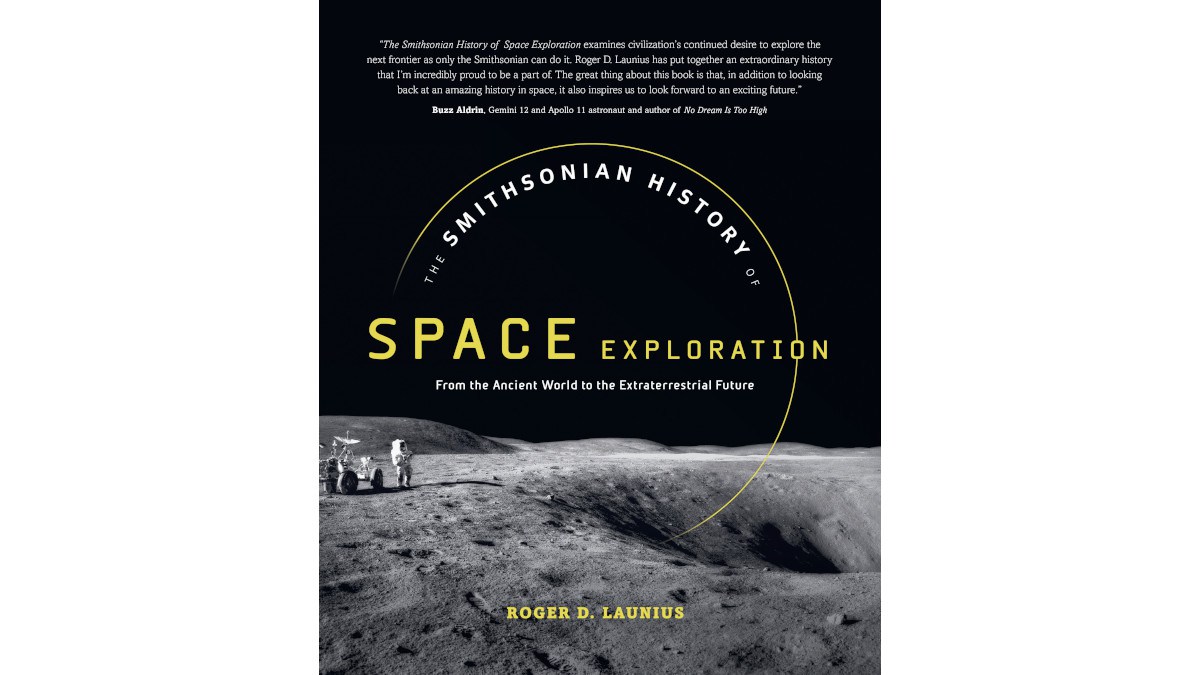
Though some might say we’re currently in a bit of a lull in the space exploration department (though NASA and other groups are still working on some pretty cool stuff), there have always been waxings and wanings of the push to explore the universe outside our own backyard. It’s only a matter of time before we have another positive push.
A new book put out by Smithsonian Books takes us on a journey of the history of space exploration and study, from the ancients through the Space Race to today, and it even looks into the future for what and how we might explore next.
The Smithsonian History of Space Exploration: From the Ancient World to the Extraterrestrial Future is a very heavy book filled with 400 slick pages of gorgeous photos, drawn imaginings, charts and diagrams, and fascinating text. This is no coffee table book (though it would look great on a coffee table). There is real depth here. Though you’ll need to dig into other sources to get into equations and theoretical math, this book goes beyond the surface level and still includes plenty of numbers and details, and, my favorite, lots of charts, graphs, diagrams, and other visuals for close examination.
Space historian author Roger D. Launius gathered together the highlights of space exploration as well as a lot of detail and lesser known parts of the history. The breathtaking photos are mostly from NASA, including plenty of rarely seen images). He was sure to also include solar system diagrams, vehicle and probe diagrams with labels, a Halley’s comet diagram, as well as lots of resources you don’t generally see, such as stats and specs. Read this book and your head will be full of the entire history of space exploration, and a solid knowledge about what will or can come next.
Even Buzz Aldrin gives the book his stamp of approval:
Examines civilization’s continued desire to explore the next frontier as only the Smithsonian can do it. Roger D. Launius has put together an extraordinary history that I’m incredibly proud to be a part of.
The book goes through space exploration history mostly sequentially, with a bit of theming in some of the chapters. It begins in ancient and medieval history, moving on to World War II, the Space Age, the race to the moon, the Shuttle program, Mars missions, and beyond. All the text is written to be accessible to the layperson, but it’s still filled with scientific terminology and the science behind our planet’s space exploration history.
Here are a few bits of information that I learned:
I learned that in 1973 Vatican City put out postage stamps honoring the work of Nicolaus Copernicus, but didn’t admit Galileo was right for two more decades. I learned about the International Geophysical Year (1957-1958), which was a series of scientific experiments and projects worked on by multiple nations. I learned what Lagrange points are and how they’re useful for satellites and for probes studying far-off worlds. I learned that the Soviets worked very hard to attempt to reach Mars as early as 1960.
Here is a brief breakdown of some of what you can find in each chapter:
- Chapter 1: Laying the Foundations for Space Exploration—Ancient and medieval history, notions of what was up in space, how they thought the solar system was arranged, studying the night sky, rockets used in war, the science of rockets and flight, and space exploration in popular culture.
- Chapter 2: World War II Paves the Way for Space Exploration—Rocket-powered aircraft, pressure suits, and rocket test launches.
- Chapter 3: Making Space Exploration Real—Satellite photos, more rocket testing, and UFOs and science fiction.
- Chapter 4: The Space Age Dawns—Sputnik, the space race, Van Allen radiation belts, NASA and its early missions, and spacesuit technology.
- Chapter 5: The Race to the Moon—Collaborations with the Soviets, taking space walks, lunar exploration and orbiter technology, women in NASA, more about pop culture, and Apollo 11 and the later Apollo missions.
- Chapter 6: New Nations, New Missions—Countries all over the world that are participating in space exploration, the sun and other planets, and the European Space Agency.
- Chapter 7: Space Planes and Orbital Stations—Planes that fly in space, space stations that orbit the Earth, the Space Shuttle, and space tourism.
- Chapter 8: The Lure of the Red Planet—This chapter pulls Mars out and examines it on its own, including the history, references in pop culture, reasons to explore Mars, exploration so far by the Russians and by us, Mars rovers, and the possibilities for future manned missions to Mars.
- Chapter 9: Beyond Mars—Deep space missions and SETI.
- Chapter 10: Transterrestrial Expectations—Commercial space flight, alternate ways to get to space (space elevators, anyone?), returning to the moon, and space colonies.
As you can see, the book’s content spans the ages as well as subjects of study and even who was doing the studying. And the compelling storytelling in this book will inform while the imagery awes. For anyone interested in the history of space exploration, where we are with it now, and where we will go next, The Smithsonian History of Space Exploration: From the Ancient World to the Extraterrestrial Future is a perfect gift, for a holiday or “just because.” Or just buy it for yourself! I also highly recommend it for kids who are interested in space. If they’re too young to understand the text, they can still take in the images and study the diagrams, and they’ll soon grow to understand the rest of the book’s content. Five stars.
Note: I received a copy of this book for review purposes. The lifelong passion for space is entirely my own.



